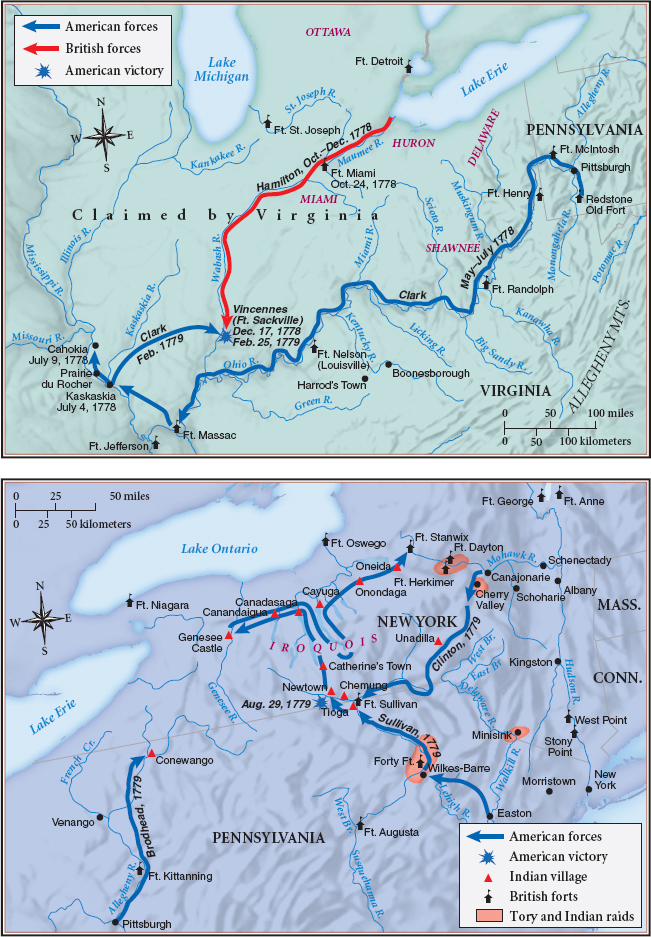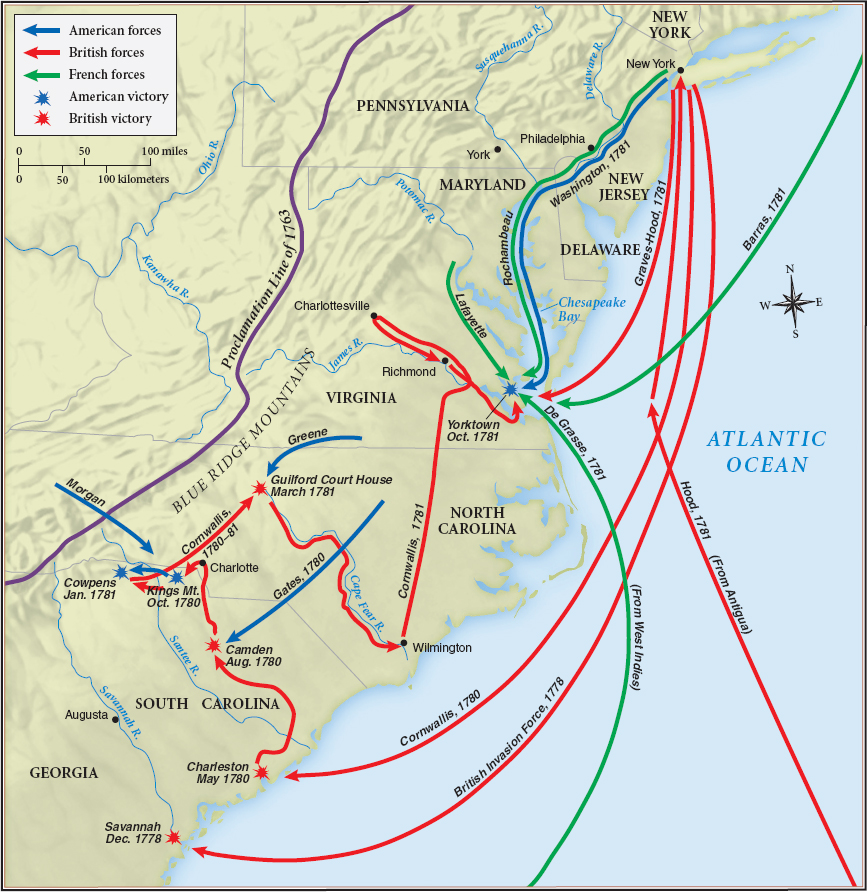War in the South
The French alliance did not bring a rapid end to the war. When France entered the conflict in June 1778, it hoped to seize all of Britain’s sugar islands. Spain, which joined the war against Britain in 1779, aimed to regain Florida and the fortress of Gibraltar at the entrance to the Mediterranean Sea.

Britain’s Southern Strategy For its part, the British government revised its military strategy to defend the West Indies and capture the rich tobacco- and rice-growing colonies: Virginia, the Carolinas, and Georgia. Once conquered, the ministry planned to use the Scottish Highlanders in the Carolinas and other Loyalists to hold them. It had already mobilized the Cherokees and Delawares against the land-hungry Americans and knew that the Patriots’ fears of slave uprisings weakened them militarily (Map 6.3). As South Carolina Patriots admitted to the Continental Congress, they could raise only a few recruits “by reason of the great proportion of citizens necessary to remain at home to prevent insurrection among the Negroes.”
The large number of slaves in the South made the Revolution a “triangular war,” in which African Americans constituted a strategic problem for Patriots and a tempting, if dangerous, opportunity for the British. Britain actively recruited slaves to its cause. The effort began with Dunmore’s controversial proclamation in November 1775 recruiting slaves to his Ethiopian Regiment. In 1779, the Philipsburg Proclamation declared that any slave who deserted a rebel master would receive protection, freedom, and land from Great Britain. Together, these proclamations led some 30,000 African Americans to take refuge behind British lines. George Washington initially barred blacks from the Continental army, but he relented in 1777. By war’s end, African Americans could enlist in every state but South Carolina and Georgia, and some 5,000 — slave and free — fought for the Patriot cause (Thinking Like a Historian).
It fell to Sir Henry Clinton — acutely aware of the role slaves might play — to implement Britain’s southern strategy. From the British army’s main base in New York City, Clinton launched a seaborne attack on Savannah, Georgia. Troops commanded by Colonel Archibald Campbell captured the town in December 1778. Mobilizing hundreds of blacks to transport supplies, Campbell moved inland and captured Augusta early in 1779. By year’s end, Clinton’s forces and local Loyalists controlled coastal Georgia and had 10,000 troops poised for an assault on South Carolina.

In 1780, British forces marched from victory to victory (Map 6.4). In May, Clinton forced the surrender of Charleston, South Carolina, and its garrison of 5,000 troops. Then Lord Charles Cornwallis assumed control of the British forces and, at Camden, defeated an American force commanded by General Horatio Gates, the hero of Saratoga. Only 1,200 Patriot militiamen joined Gates at Camden, a fifth of the number at Saratoga. Cornwallis took control of South Carolina, and hundreds of African Americans fled to freedom behind British lines. The southern strategy was working.
Then the tide of battle turned. Thanks to another republican-minded European aristocrat, the Marquis de Lafayette, France finally dispatched troops to the American mainland. A longtime supporter of the American cause, Lafayette persuaded King Louis XVI to send General Comte de Rochambeau and 5,500 men to Newport, Rhode Island, in 1780. There, they threatened the British forces holding New York City.
Guerrilla Warfare in the Carolinas Meanwhile, Washington dispatched General Nathanael Greene to recapture the Carolinas, where he found “a country that has been ravaged and plundered by both friends and enemies.” Greene put local militiamen, who had been “without discipline and addicted to plundering,” under strong leaders and unleashed them on less mobile British forces. In October 1780, Patriot militia defeated a regiment of Loyalists at King’s Mountain, South Carolina, taking about one thousand prisoners. American guerrillas commanded by the “Swamp Fox,” General Francis Marion, also won a series of small but fierce battles. Then, in January 1781, General Daniel Morgan led an American force to a bloody victory at Cowpens, South Carolina. In March, Greene’s soldiers fought Cornwallis’s seasoned army to a draw at North Carolina’s Guilford Court House. Weakened by this war of attrition, the British general decided to concede the Carolinas to Greene and seek a decisive victory in Virginia. There, many Patriot militiamen had refused to take up arms, claiming that “the Rich wanted the Poor to fight for them.”
Exploiting these social divisions, Cornwallis moved easily through the Tidewater region of Virginia in the early summer of 1781. Reinforcements sent from New York and commanded by General Benedict Arnold, the infamous Patriot traitor, bolstered his ranks. As Arnold and Cornwallis sparred with an American force led by Lafayette near the York Peninsula, Washington was informed that France had finally sent its powerful West Indian fleet to North America, and he devised an audacious plan. Feigning an assault on New York City, he secretly marched General Rochambeau’s army from Rhode Island to Virginia. Simultaneously, the French fleet took control of Chesapeake Bay. By the time the British discovered Washington’s scheme, Cornwallis was surrounded, his 9,500-man army outnumbered 2 to 1 on land and cut off from reinforcement or retreat by sea. In a hopeless position, Cornwallis surrendered at Yorktown in October 1781.

The Franco-American victory broke the resolve of the British government. “Oh God! It is all over!” Lord North exclaimed. Isolated diplomatically in Europe, stymied militarily in America, and lacking public support at home, the British ministry gave up active prosecution of the war on the American mainland.
IDENTIFY CAUSES